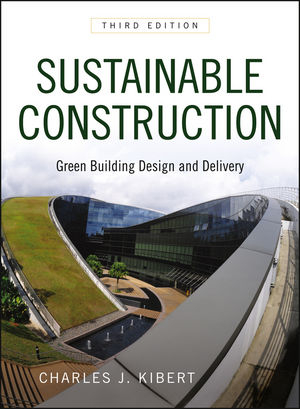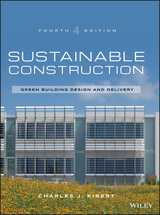
Sustainable Construction
John Wiley & Sons Ltd (Verlag)
978-0-470-90445-9 (ISBN)
- Titel ist leider vergriffen;
keine Neuauflage - Artikel merken
Charles J. Kibert, PhD, PE, is a professor in the M. E. Rinker Sr. School of Building Construction at the University of Florida, Gainesville, and founded the university's Powell Center for Construction and Environment as well as Task Group 16 (Sustainable Construction) and Task Group 39 (Deconstruction) for CIB. He is cofounder and chairman of the Cross Creek Initiative, a nonprofit industry/university joint venture that seeks to implement sustainability principles in construction. He has been cochair of the U.S. Green Building Council (USGBC) Curriculum and Accreditation Committee and a board member of the Green Building Initiative.
Foreword xiii Preface xv Chapter 1 Introduction and Overview 1 The Shifting Landscape for High-Performance Buildings 3 Sustainable Development and Sustainable Construction 6 The Vocabulary of Sustainable Development and Sustainable Construction 7 Sustainable Design, Ecological Design, and Green Design 10 Rationale for High-Performance Green Buildings 12 State and Local Guidelines for High-Performance Construction 13 Green Building Progress and Obstacles 14 Book Organization 16 Trends in High-Performance Green Building 16 Case Study: Kroon Hall, Yale University, New Haven, Connecticut 22 Summary and Conclusions 25 Notes 25 References 27 Part I Green Building Foundations 29 Chapter 2 Background 33 Ethics and Sustainability 35 Basic Concepts and Vocabulary 43 Major Environmental and Resource Concerns 52 The Green Building Movement 60 Case Study: OWP 11, Stuttgart, Germany 70 Summary and Conclusions 72 Notes 73 References 76 Chapter 3 Ecological Design 79 Design versus Ecological Design 80 Historical Perspective 82 Contemporary Ecological Design 88 Key Green Building Publications: Early 1990s 89 Key Contemporary Publications about Ecological Design 92 Future Ecological Design 97 Thermodynamics: Limits on Recycling and the Dissipation of Materials 104 Thought Piece: Regenerative Development and Design: Working with the Whole by Bill Reed 109 Summary and Conclusions 111 Notes 111 References 112 Part II Assessing High-Performance Green Buildings 115 Chapter 4 Green Building Assessment 119 Major Green Building Assessment Systems Used in the United States 121 International Building Assessment Systems 123 BREEAM CaseStudy: AHVLA Stores Building, Weybridge, United Kingdom 127 Green Star Case Study 133 Thought Piece: Shifting Emphasis in Green Building Performance Assessment by Raymond J. Cole 138 Summary and Conclusions 141 Notes 141 References 142 Chapter 5 The US Green Building Council LEED Building Rating System 143 Brief History of LEED 144 Structure of the LEED Suite of Building Assessment Systems 145 LEED Credentials 146 The LEED Process 147 LEED Categories 152 Case Study: The Heavener Football Complex, University of Florida, Gainesville 169 Summary and Conclusions 173 Notes 173 Chapter 6 The Green Globes Building Assessment System 175 The Green Globes Process 176 Green Globes Verification and Certification 177 Structure of the ANSI/GBI 01-2010 Standard 177 The Green Globes Professional and Green Globes Assessor 180 Case Study: Health Sciences Building, St. Johns River State College, St. Augustine, Florida 181 Summary and Conclusions 187 Note 187 Part III Green Building Design 189 Chapter 7 The Green Building Design Process 191 Conventional versus Green Building Delivery Systems 191 Executing the Green Building Project 195 The Integrated Design Process 199 Role of the Charrette in the Design Process 204 Green Building Documentation Requirements 206 Case Study: Theaterhaus, Stuttgart, Germany 208 Summary and Conclusions 213 Notes 213 Chapter 8 The Sustainable Site and Landscape 215 Land and Landscape Approaches for Green Buildings 216 Land Use Issues 217 Sustainable Landscapes 223 Enhancing Ecosystems 230 Stormwater Management 230 Low-Impact Development 231 Heat Island Mitigation 236 Light Trespass and Pollution Reduction 237 Assessment of Sustainable Sites: The Sustainable Sites Initiative 238 Summary and Conclusions 240 Notes 240 References 241 Chapter 9 Energy and Carbon Footprint Reduction 243 Building Energy Issues 244 High-Performance Building Energy Design Strategy 248 Passive Design Strategy 251 Building Envelope 259 Internal Load Reduction 265 Active Mechanical Systems 268 Water-Heating Systems 274 Electrical Power Systems 275 Innovative Energy Optimization Strategies 281 Renewable Energy Systems 284 Fuel Cells 287 Smart Buildings and Energy Management Systems 288 Ozone-Depleting Chemicals in HVAC&R Systems 289 Reducing the Carbon Footprint of the Built Environment 290 Case Study: River Campus Building One, Oregon Health and Science University, Portland 296 Thought Piece: Building Energy Analysis: The Present and Future by Ravi Srinivasan 302 Summary and Conclusions 303 Notes 304 References 305 Chapter 10 Built Environment Hydrologic Cycle 309 Global Water Resource Depletion 310 Water Distribution and Shortages in the United States 311 Hydrologic Cycle Terminology 315 High-Performance Building Hydrologic Cycle Strategy 316 Designing the High-Performance Building Hydrologic Cycle 332 Water Budget Rules of Thumb (Heuristics) 336 Sustainable Stormwater Management 337 Landscaping Water Efficiency 345 Case Study: LOTT Clean Water Alliance, Olympia, Washington 347 Summary and Conclusions 349 Notes 350 References 351 Chapter 11 Closing Materials Loops 353 The Challenge of Materials and Product Selection 355 Distinguishing between Green Building Products and Green Building Materials 357 LCA of Building Materials and Products 365 Environmental Product Declarations 367 Materials and Product Certification Systems 368 Key and Emerging Construction Materials and Products 370 Design for Deconstruction and Disassembly 378 Case Study: Project XX Office Building, Delft, Netherlands 381 Thought Piece: Closing Materials Loops by Bradley Guy 385 Summary and Conclusions 386 Notes 387 References 388 Chapter 12 Indoor Environmental Quality 389 Indoor Environmental Quality: The Issues 389 Integrated IEQ Design 399 Addressing the Main Components of Integrated IEQ Design 402 Emissions from Building Materials 422 Economic Benefits of Good Indoor Environmental Quality 429 Summary and Conclusions 430 Notes 430 References 431 Part IV Green Building Implementation 433 Chapter 13 Construction Operations and Commissioning 435 Site Protection Planning 435 Managing Indoor Air Quality during Construction 440 Construction Materials Management 444 Construction and Demolition Waste Management 448 Commissioning 450 Thought Piece: The Role of Commissioning in High-Performance Green Buildings by John Chyz 457 Summary and Conclusions 459 Notes 459 References 460 Chapter 14 Green Building Economics 461 General Approach 462 The Business Case for High-Performance Green Buildings 465 The Economics of Green Building 466 Quantifying Green Building Benefits 468 Managing First Costs 475 Tunneling through the Cost Barrier 479 Summary and Conclusions 481 Notes 481 References 482 Chapter 15 The Cutting Edge of Sustainable Construction 483 Passive Survivability 484 Cutting Edge: Case Studies 486 Case Study: The Federal Building, San Francisco, California 486 Articulating Performance Goals for Future Green Buildings 490 The Challenges 491 Revamping Ecological Design 497 Today s Cutting Edge 501 Thought Piece: Processes, Geometries, and Principles: Design in a Sustainable Future by Kim Sorvig 504 Summary and Conclusions 506 Notes 506 References 507 Appendix A Quick Reference for LEED 3.0 509 Appendix B The Sustainable Sites Initiative (SITES ) Guidelines and Performance Benchmarks 2009 513 Appendix C Unit Conversions 517 Abbreviations and Acronyms 519 Glossary 525 Index 537
| Erscheint lt. Verlag | 16.11.2012 |
|---|---|
| Zusatzinfo | illustrations |
| Verlagsort | Chichester |
| Sprache | englisch |
| Maße | 226 x 283 mm |
| Gewicht | 1544 g |
| Themenwelt | Technik ► Architektur |
| Technik ► Bauwesen | |
| ISBN-10 | 0-470-90445-3 / 0470904453 |
| ISBN-13 | 978-0-470-90445-9 / 9780470904459 |
| Zustand | Neuware |
| Informationen gemäß Produktsicherheitsverordnung (GPSR) | |
| Haben Sie eine Frage zum Produkt? |
aus dem Bereich



